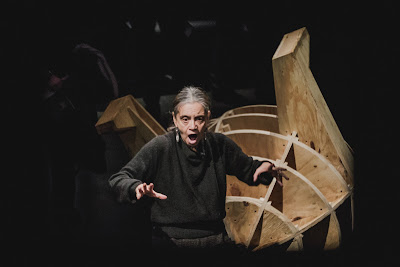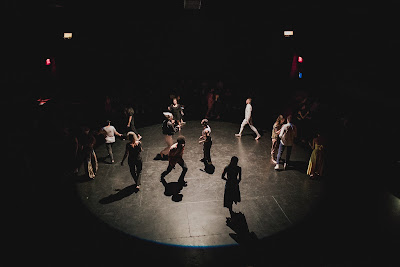 |
| Daria Faïn in her mayday heyday parfait at BRIC House Below: members of The Commons Choir (photo: Ryan Muir) |
You find yourself surrounded by resonant sneezes, explosive farts, otherwise unidentifiable big or more subtle expulsions of air from a multitude of gesticulating bodies.
No. Not the subway system.
It's the sonic opening of mayday heyday parfait, a new 90-minute work presented by The Commons Choir at BRIC House. This large, multifaceted, multicultural ensemble, co-directed by choreographer Daria Faïn and poet Robert Kocik, represents artists spanning disciplines from dance to poetry to song.
For the first several minutes, the audience stands in the middle of the performance space with performers darting or weaving through them. Every sound has a clear launchpad within a moving body. You watch--and feel--it being produced. To experience this at maximum intensity, keep your eyes on Faïn's clenched movements. But every dancer contributes to a variable soundscape that pulls the standing, slightly shifting audience together into one organism--like a forest with sounds whistling through its canopy and rustling through its understory.
After a time, the watchers can take seats on the space's perimeter, and the story continues with words spoken by a man, a woman and a young girl. In his opening remarks, the man mentions Brooklyn--BRIC's home, of course, and a symbol of historic, if threatened, class and cultural diversity. I forget now what the woman said--and my scrawled notes are of minor help--but the youngster wrapped up by thrice intoning three words, like a mantra and admonition: Change what happens.
Those words combine a sense of inevitability (shit happens and will happen) with a directive: Do your magick. The ensuing performance continues the interdependency of physical movement and vocalization testifying for the body as a site of individuality, intelligence, will, communication and meaningful interaction. The vocalizing is varied. Dancer Saúl Ulerio, for instance, gradually rolls onto his side and front while quietly emitting a kind of musical moan--un-ing. At other moments, strings of words like "uninhabitable worst-case scenario invaluable" float by in an enigmatic stream.
As the movers move, the arrangements look like drifting patchworks of individual bodies doing individual things and putting sound into a site, and that seems okay because no one is impinging on the space of another. I wrote--and think I actually heard someone say--"You can only be who you are." Co-existence and working together do not render us all exactly the same. Cannot. Should not. How could it? Why would it?
Sometime later, Ulerio says something else that sticks with me: "That which I can't know about myself is you."
Writing my notes, I was one of a handful of people who did not opt to reassemble in the middle of the space for the work's resolution and, once again, become bathed in sound. This time, people sat in a large, round bunch like herded cows, and they were ringed by the performers, vocal music rising, falling, burbling, reverberating. At the end, the performers announced their names: Martita Abril, Massimiliano Balduzzi, Ilona Bito, Yoon Sun Choi, Lydia Chrisman, Ichi Go, Alvaro Gonzales Dupuy, Antígona González, Michael Ingle, Aram Jibilian, Anaïs Maviel, Jean Carla Rodea, Saúl Ulerio, Drew Devero, Cecilia Woolfolk and Fay Victor.
Daria Faïn: Co-director and choreographer
Robert Kocik: Co-director and librettist
Darius Jones: Composer
Anaïs Maviel: Composer & Musical Director
Tuce Yasak: Light Designer
AshakaGivens: Costume Design
Eternal Polk: Video Design
Dov Tiefenback: Sound Design
Saúl Ulerio: Assistant choreographer
mayday heyday parfait continues through Sunday, November 12 with performances tonight and Saturday at 8pm and Sunday at 3pm. For information and tickets, click here.
BRIC Arts Media
647 Fulton Street (entrance on Rockwell Place), Brooklyn
(directions)






